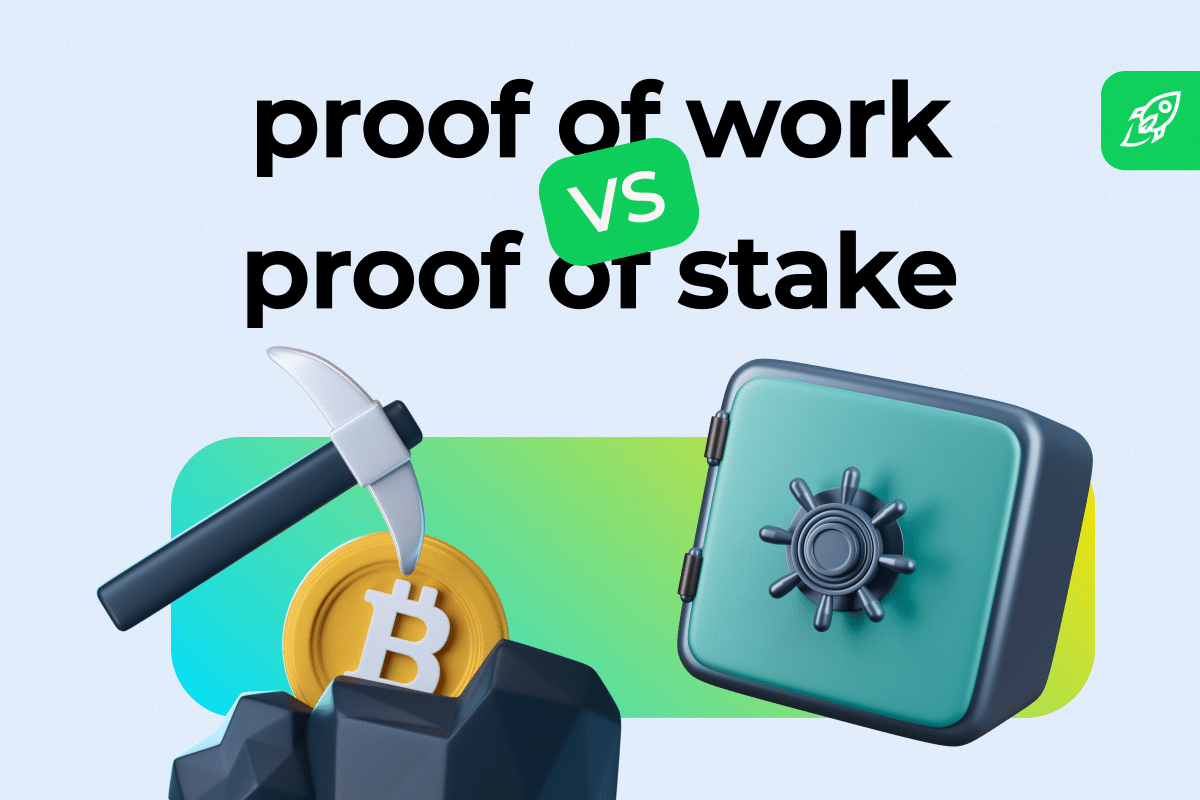Cryptocurrencies operate on blockchain technology, which relies on consensus mechanisms to maintain trust and security. Two major consensus algorithms are proof of work (PoW) and proof of stake (PoS). Each has distinct features that affect how a blockchain network functions. In this article, I’ll explore these differences to help you understand their implications in the world of cryptocurrencies.
Understanding Proof of Work
Proof of work is a consensus mechanism used by blockchain networks to verify transactions and add new blocks of transactions. In this system, miners employ high-powered computers to solve complex mathematical equations known as cryptographic puzzles. The first miner to solve the puzzle gets the right to add a new block to the blockchain and receives a block reward in the form of cryptocurrency. This process ensures the security of the blockchain by making it extremely hard and resource-intensive for a bad actor to manipulate the network.
Pros & Cons
Pros:
Security. PoW requires a significant amount of computational power, making the network secure against attacks.Decentralization. It prevents any single central authority from having control over the blockchain network.
Cons:
Energy Consumption. High-powered computers used in solving complex puzzles consume much electricity.Slower and Expensive. The process can be slower and more costly than other consensus methods, like PoS.
Examples of Use Cases
Bitcoin is the most notable example of a cryptocurrency that uses proof of work. It pioneered this method, setting a standard for a decentralized and secure way to verify transactions.
Understanding Proof of Stake
Proof of stake is a newer consensus mechanism where the process of validating transactions on a blockchain network depends on the validators’ economic stake in the network. In a proof-of-stake blockchain, validators are chosen to create new blocks and validate transactions based on the number of coins they hold and are willing to “stake” as collateral. Unlike PoW, PoS doesn’t require solving complex puzzles using high-powered computers, which makes it more energy-efficient.
Pros & Cons
Pros:
Energy Efficiency. It is significantly more energy-efficient than PoW since it doesn’t require massive amounts of computational power.Faster and Cheaper. The proof-of-stake consensus mechanism can validate transactions more quickly and at a lesser cost, benefiting users with faster transaction times and lower fees.
Cons:
Risk of Centralization. Wealthier participants who can stake more may have more control. Potentially, this could lead to centralization issues and other challenges for other network users.Security Concerns. There are debates about whether PoS is as secure as PoW, with some arguing that it’s more susceptible to certain types of attacks.
Examples of Use Cases

Ethereum, which initially used proof of work, has transitioned to being a proof-of-stake cryptocurrency to address concerns about energy usage and efficiency. Many newer proof-of-stake cryptocurrencies are also adopting this model, seeing it as a more sustainable and scalable option for their blockchain networks compared to the high-energy proof-of-work system.
Proof of Work vs. Proof of Stake
Understanding the key differences between proof of work and proof of stake can allow crypto investors and enthusiasts to better navigate the cryptocurrency landscape. Each consensus mechanism has its own unique features that cater to different priorities, be it security, energy efficiency, or transaction speed.
Energy Consumption and Computing Power Requirements
Proof of Work
In PoW, miners solve complex mathematical puzzles to validate blocks of transactions and add them to the blockchain. This process, often termed ‘mining,’ requires substantial computational power, typically involving high-powered computers. The competition between miners to solve the computational puzzle first leads to significant energy consumption, contributing to high energy costs—an issue with proof of work that’s been widely discussed.
Proof of Stake
A proof-of-stake system, an alternative to proof-of-work, drastically reduces energy consumption. Instead of relying on mining power to validate transactions, it selects validators based on their stake in the network. The hardware requirements for a PoS system are far less demanding, as solving complex puzzles is not part of the process. This reduced need for energy-intensive hardware makes PoS much more energy-efficient.
Efficiency and Transaction Speed
Proof of Work
While secure, PoW can be less efficient in terms of transaction processing speed. The competition between miners to solve puzzles and earn mining rewards can lead to congestion and slower transaction times, especially on networks with high usage.
Proof of Stake
In contrast, a proof of stake system typically offers higher efficiency and faster transaction processing. Without the need for mining, the process of validating transactions and adding them to the blockchain can be quicker. So, PoS can be advantageous for networks aiming for scalability, like Ethereum 2.0.
Security and Fraud Prevention
Proof of Work
PoW has a strong security track record, largely due to the substantial mining power required to add a block to the blockchain. This makes it incredibly difficult for a malicious actor to control enough computational power to manipulate the network or approve fraudulent transactions.
Proof of Stake
Although PoS is considered secure, some argue it might be more vulnerable to certain attacks compared to PoW. In PoS, validators are deterred from approving fraudulent transactions by a security deposit, which can be lost if dishonesty is detected. While this mechanism is effective, the debate about its comparative security to PoW continues.
Cryptocurrency Transactions and Transaction Fees
Proof of Work
The cost of transaction fees in PoW networks may vary, often influenced by the network’s congestion and the competition between miners. During times of high demand, transaction fees can surge significantly.
Proof of Stake
In a proof-of-stake system, transaction fees tend to be lower. Since the energy costs and hardware requirements are less significant, the network can afford to charge less per transaction. This aspect is particularly appealing in networks that aim for high transaction throughput and lower costs for users, like Ethereum 2.0.
Understanding these differences is crucial for anyone—investors, developers, and users—involved in the cryptocurrency space. Each consensus mechanism has inherent strengths and weaknesses, shaping the blockchain network’s performance, security, and user experience.
FAQ
How many consensus mechanisms are there?
In the realm of decentralized cryptocurrency networks, there’s a variety of consensus mechanisms, each designed to validate blocks and maintain the integrity of the blockchain. While there isn’t a definitive number, as developers are continuously innovating, the most recognized ones include the proof-of-work (PoW) and proof-of-stake (PoS) systems, along with others like Delegated Proof of Stake (DPoS), Proof of Authority (PoA), and Proof of Burn (PoB), among others.
Each consensus algorithm has its unique approach and methodology. For instance, PoW relies on miners solving complex mathematical problems to earn block rewards, whereas PoS systems choose validators based on their stake in the network. These mechanisms are continually evolving, adapting to the needs of the crypto world and its diverse array of applications.
What is the best consensus mechanism?
Identifying the “best” consensus mechanism isn’t straightforward, as it largely depends on the specific needs and goals of each decentralized cryptocurrency network. PoW consensus mechanism, known for its robust security and decentralized nature, is highly valued in networks where these attributes are prioritized. On the other hand, PoS systems are often preferred for their energy efficiency and faster transaction validation process.
The ideal consensus algorithm for a particular network considers factors like security, scalability, energy consumption, and the ease of validating blocks. Some networks even adopt hybrid models or develop unique mechanisms to best suit their objectives. It’s not about finding a one-size-fits-all solution but rather choosing a mechanism that aligns with the network’s vision and the interests of its users, ensuring the same money and resources are spent effectively.
What is proof of work vs. proof of stake?
Proof of work (PoW) and proof of stake (PoS) are two of the most prominent consensus mechanisms in decentralized cryptocurrency networks. PoW, the older of the two, requires participants (miners) to solve complex mathematical puzzles to validate transactions and add new blocks to the blockchain. This process cannot be executed without substantial computational power and energy, so even though it is secure, it is also energy-intensive. Miners’ efforts don’t go unnoticed: they get block rewards, an incentive for contributing their computing power.
In contrast, PoS systems represent a more energy-efficient approach. Instead of relying on computational power to validate blocks, PoS chooses validators based on the number of coins they hold and are willing to “stake” as collateral. This method significantly reduces the energy requirement because it doesn’t involve solving complex puzzles. Validators are incentivized through transaction fees or other reward mechanisms. The shift from PoW to PoS, as seen in major cryptocurrencies like Ethereum (with its move to Ethereum 2.0), highlights the ongoing evolution and search for more sustainable and scalable solutions in the crypto world.
Disclaimer: Please note that the contents of this article are not financial or investing advice. The information provided in this article is the author’s opinion only and should not be considered as offering trading or investing recommendations. We do not make any warranties about the completeness, reliability and accuracy of this information. The cryptocurrency market suffers from high volatility and occasional arbitrary movements. Any investor, trader, or regular crypto users should research multiple viewpoints and be familiar with all local regulations before committing to an investment.
Source: https://changelly.com/blog/proof-of-work-vs-proof-of-stake/

